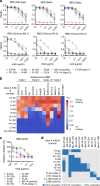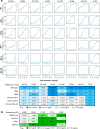Structural basis for a conserved neutralization epitope on the receptor-binding domain of SARS-CoV-2
- PMID: 36658148
- PMCID: PMC9852238
- DOI: 10.1038/s41467-023-35949-8
Structural basis for a conserved neutralization epitope on the receptor-binding domain of SARS-CoV-2
Abstract
Antibody-mediated immunity plays a crucial role in protection against SARS-CoV-2 infection. We isolated a panel of neutralizing anti-receptor-binding domain (RBD) antibodies elicited upon natural infection and vaccination and showed that they recognize an immunogenic patch on the internal surface of the core RBD, which faces inwards and is hidden in the "down" state. These antibodies broadly neutralize wild type (Wuhan-Hu-1) SARS-CoV-2, Beta and Delta variants and some are effective against other sarbecoviruses. We observed a continuum of partially overlapping antibody epitopes from lower to upper part of the inner face of the RBD and some antibodies extend towards the receptor-binding motif. The majority of antibodies are substantially compromised by three mutational hotspots (S371L/F, S373P and S375F) in the lower part of the Omicron BA.1, BA.2 and BA.4/5 RBD. By contrast, antibody IY-2A induces a partial unfolding of this variable region and interacts with a conserved conformational epitope to tolerate all antigenic variations and neutralize diverse sarbecoviruses as well. This finding establishes that antibody recognition is not limited to the normal surface structures on the RBD. In conclusion, the delineation of functionally and structurally conserved RBD epitopes highlights potential vaccine and therapeutic candidates for COVID-19.
© 2023. The Author(s).
Conflict of interest statement
The authors declare no competing interests.
Figures





Similar articles
-
The presence of broadly neutralizing anti-SARS-CoV-2 RBD antibodies elicited by primary series and booster dose of COVID-19 vaccine.PLoS Pathog. 2024 Jun 10;20(6):e1012246. doi: 10.1371/journal.ppat.1012246. eCollection 2024 Jun. PLoS Pathog. 2024. PMID: 38857264 Free PMC article.
-
Defining a de novo non-RBM antibody as RBD-8 and its synergistic rescue of immune-evaded antibodies to neutralize Omicron SARS-CoV-2.Proc Natl Acad Sci U S A. 2023 Dec 26;120(52):e2314193120. doi: 10.1073/pnas.2314193120. Epub 2023 Dec 18. Proc Natl Acad Sci U S A. 2023. PMID: 38109549 Free PMC article.
-
A Glycosylated RBD Protein Induces Enhanced Neutralizing Antibodies against Omicron and Other Variants with Improved Protection against SARS-CoV-2 Infection.J Virol. 2022 Sep 14;96(17):e0011822. doi: 10.1128/jvi.00118-22. Epub 2022 Aug 16. J Virol. 2022. PMID: 35972290 Free PMC article.
-
Broad cross-reactivity across sarbecoviruses exhibited by a subset of COVID-19 donor-derived neutralizing antibodies.Cell Rep. 2021 Sep 28;36(13):109760. doi: 10.1016/j.celrep.2021.109760. Epub 2021 Sep 8. Cell Rep. 2021. PMID: 34534459 Free PMC article.
-
Targeting the Spike Receptor Binding Domain Class V Cryptic Epitope by an Antibody with Pan-Sarbecovirus Activity.J Virol. 2023 Jul 27;97(7):e0159622. doi: 10.1128/jvi.01596-22. Epub 2023 Jul 3. J Virol. 2023. PMID: 37395646 Free PMC article.
Cited by
-
Delineating the functional activity of antibodies with cross-reactivity to SARS-CoV-2, SARS-CoV-1 and related sarbecoviruses.PLoS Pathog. 2024 Oct 28;20(10):e1012650. doi: 10.1371/journal.ppat.1012650. eCollection 2024 Oct. PLoS Pathog. 2024. PMID: 39466880 Free PMC article.
-
Engineering a SARS-CoV-2 vaccine targeting the RBD cryptic-face via immunofocusing.bioRxiv [Preprint]. 2024 Jun 5:2024.06.05.597541. doi: 10.1101/2024.06.05.597541. bioRxiv. 2024. Update in: ACS Cent Sci. 2024 Sep 17;10(10):1871-1884. doi: 10.1021/acscentsci.4c00722. PMID: 38895327 Free PMC article. Updated. Preprint.
-
Longitudinal analysis of immune responses to SARS-CoV-2 recombinant vaccine S-268019-b in phase 1/2 prime-boost study.Front Immunol. 2025 Mar 5;16:1550279. doi: 10.3389/fimmu.2025.1550279. eCollection 2025. Front Immunol. 2025. PMID: 40109335 Free PMC article. Clinical Trial.
-
A Novel Conserved Linear Neutralizing Epitope on the Receptor-Binding Domain of the SARS-CoV-2 Spike Protein.Microbiol Spectr. 2023 Aug 17;11(4):e0119023. doi: 10.1128/spectrum.01190-23. Epub 2023 Jun 12. Microbiol Spectr. 2023. PMID: 37306579 Free PMC article.
-
Determination of resilience of a panel of broadly neutralizing mAbs to emerging variants of SARS-CoV-2 generated using reverse genetics.iScience. 2025 Apr 16;28(6):112451. doi: 10.1016/j.isci.2025.112451. eCollection 2025 Jun 20. iScience. 2025. PMID: 40496810 Free PMC article.
References
Publication types
MeSH terms
Substances
Supplementary concepts
LinkOut - more resources
Full Text Sources
Medical
Miscellaneous

